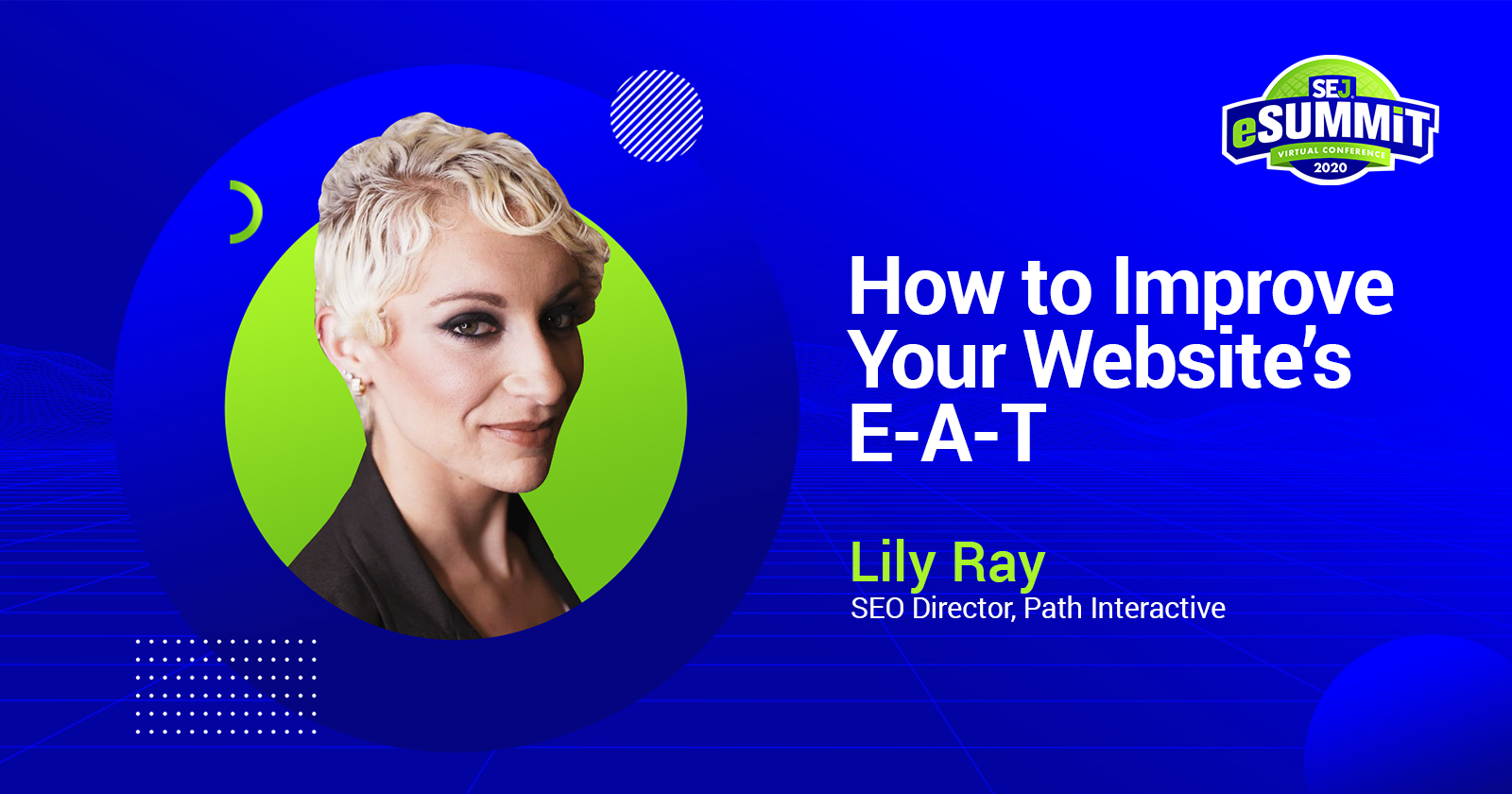Lily Ray, Director of SEO at Path Interactive, is among the key figures in the industry who often talk about Google’s concept of E-A-T: expertise, authoritativeness, and trustworthiness.
If you’ve been working in SEO over the past couple of years, you’ve probably experienced Google’s broad core algorithm updates that have rolled out.
The consensus is that E-A-T seems to be the common underlying factor behind a lot of these updates.
In her recent SEJ eSummit presentation, Ray discussed the role E-A-T plays (and does not play) in Google’s algorithms.
She also presented top-performing websites that demonstrate good E-A-T and identified the tactics and strategies that can potentially create trust issues with your website.
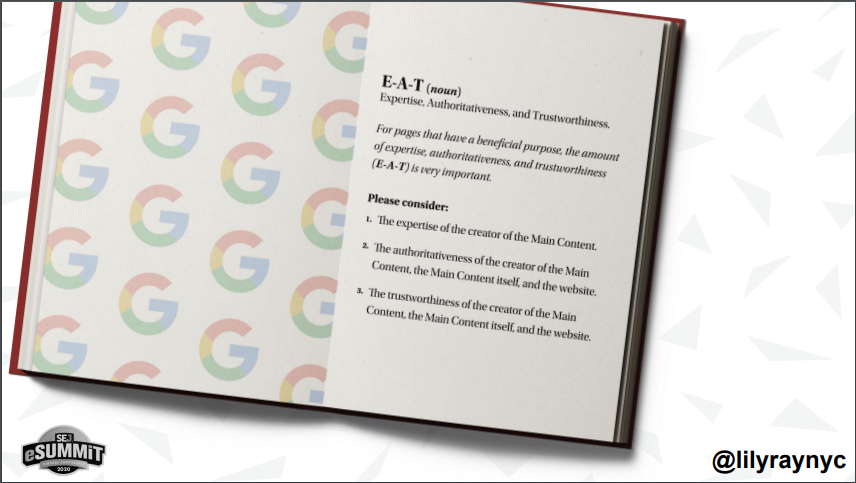
What Exactly Is E-A-T?
According to Google, E-A-T is defined as:
“Expertise, authoritativeness, and trustworthiness of the creator of the main content, the main content itself, as well as the website.”
E-A-T is not a ranking factor.
It’s not something like keywords in your title tag, using HTTPS, or considering your page speed.
That said, E-A-T is a growing trend in SEO and it’s definitely something worth paying attention to.
Why Does E-A-T Matter?
In the Google Search Quality Guidelines, E-A-T was actually mentioned 135 times.
Google published a white paper last year called How Google Fights Disinformation which talked a lot about E-A-T and the role that it plays in Google’s algorithms.
Whenever a core update happens, Google shares an article called What Webmasters Should Know About Google Core Updates which has a dedicated section to E-A-T and why you should consider it if your site has been affected by a core algorithm update.
Where Did E-A-T Come From?
The concept of E-A-T originated in the 2014 version of the Google Search Quality Guidelines, a 160-page document that explicitly defines what Google considers to be high or low quality content.
The guidelines are used to educate search quality raters, people who tasked by Google to conduct evaluations on the search results they are testing.
The raters then submit their answers and Google uses that feedback to benchmark and inform future algorithms.
The algorithms are then capable of identifying signals that correlate with E-A-T. (For example, PageRank and links.)
Now, whenever you ask Google about E-A-T, you’ll notice some common language.
It's almost like we look for signals that align with expertise, authoritativeness and trustworthiness. We should give that an acronym like E-A-T and maybe suggest people aim for this. Oh wait, we did: https://t.co/1fs2oIS54L pic.twitter.com/xNL424dDdq
— Danny Sullivan (@dannysullivan) October 11, 2019
Google Search Liaison Danny Sullivan says: “It’s almost like we look for signals that align with E-A-T…”
They use that same language in How Google Fights Disinformation:
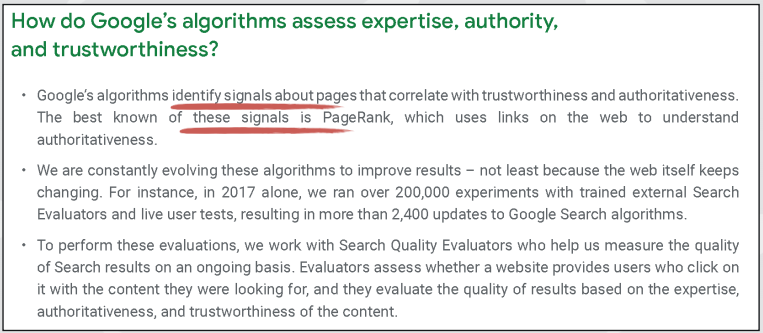
While Google has not confirmed exactly what these signals are (except for PageRank and links), it does not imply that on-page signals aren’t part of Google’s E-A-T evaluations.
It’s just that Google hasn’t explicitly confirmed, which signals are really part of E-A-T.
How Does Google Measure E-A-T?
When Ray asked this to Googlers a while back, she didn’t really get a straight answer.
She said:
“It’s almost like Google doesn’t want to talk too much about the specifics of E-A-T.
Now, why would that be the case? It’s almost like SEO’s love to spam things!
Come on, guys. Let’s own up to it.”
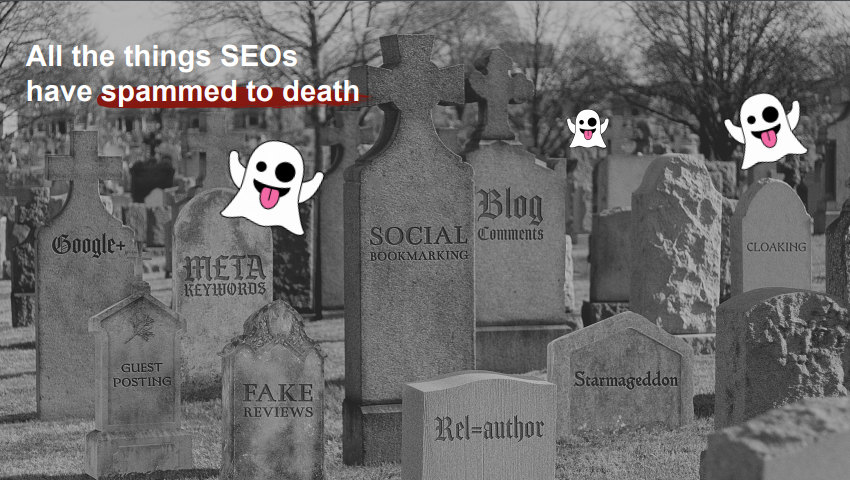
This, or maybe it’s because E-A-T is some part of a larger initiative by Google?
What Google Is (& Might Be) Up To
Search engines and social media companies have been facing government scrutiny due to disinformation abounding in their platforms.
These companies have been trying to figure out how they can reduce bad information and surface high-quality content instead.
A survey conducted by Eli Schwartz found that 77% of Americans have admitted to going online to diagnose medical symptoms.
The results are not always trustworthy, and Google knows this.
In 2016, they created Symptom Cards, a search feature that allows users to get a lot of information directly in the search results.
Google sources information by collaborating with the team of medical doctors that made up part of their Knowledge Graph, in an attempt to provide the most trustworthy medical information directly on the search results.
Ray noted how Google seems to be doing big things with health information considering The Atlantics’s story on Google’s Project Nightingale and the company’s acquisition of Fitbit around the same time.
Ray speculates:
“[M]aybe something like this is on our horizon; a Google Health Portal in which you can type your symptoms or your medical issues directly into Google and get that information in the search results themselves without the need to click on any other website, the same way that we currently have it for things like flights or jobs.”
Another thing worth noting is how the algorithm updates seem to be disproportionately impacting health and medical websites.
The August 1, 2018 update was informally labeled “Medic” for this exact reason. It significantly affected sites in the health and medical categories.
There’s a similar pattern with subsequent core updates as well.
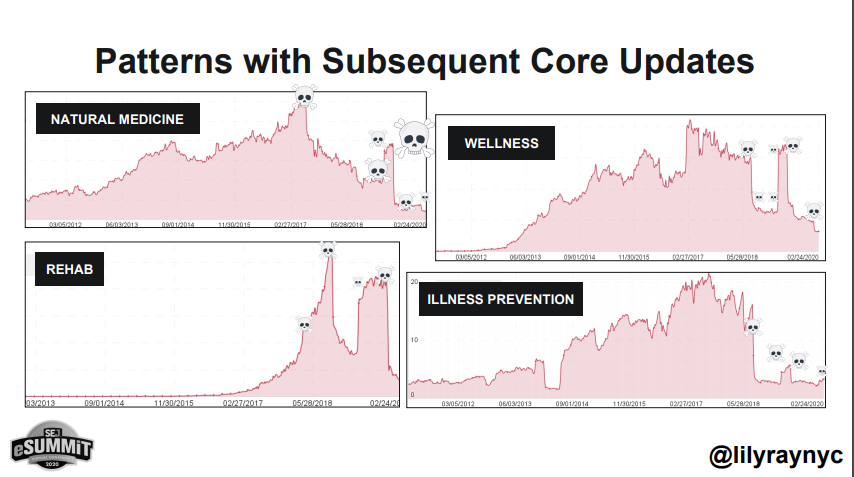
Websites that are in the natural medicine, wellness, rehab, and illness prevention categories have all felt the impact of these core updates.
This brings us to another acronym from Google called the YMYL – which stands for Your Money or Your Life.
These are websites and content that can directly impact the happiness, safety, financial security, or overall well-being of their users.
If we look at Google’s take on why they’re tackling disinformation in their products and services, it makes sense:
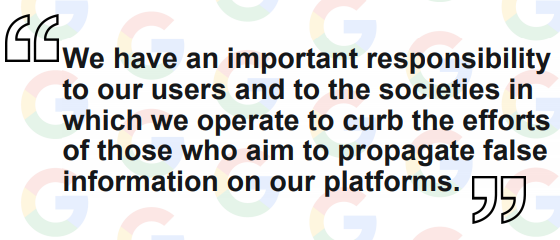
Ray thinks that E-A-T is that Google’s criteria for analyzing the trustworthiness of content and the people who publish it as a way to mitigate the spread of misinformation online.
Ultimately, only Google knows exactly which signals factor into their E-A-T evaluations, leaving SEO professionals to rely on speculation, data, and patents.
In February 2020, Bill Slawski published an article that looks into a patent released around the same time as the “Medic update” called Google Using Website Representation Vectors to Classify Sites with Expertise and Authority.
The patent application uses neural networks to understand patterns and features behind websites to classify those sites.
The classifications include:
- An expert level of sites in the health domain.
- An apprentice level of sites.
- A layperson level of sites.
This patent tells us that it is ranking pages on the basis of authority, too.
What’s important to think about is that if your website is classified as YMYL, your E-A-T is going to be held to a higher standard.
Analyzing E-A-T for SEO
SEO pros need to think specifically about the signals that align with E-A-T and look at the qualities of the websites that have been winning these core algorithm updates.
Ray has been analyzing websites for E-A-T using the following methodology:
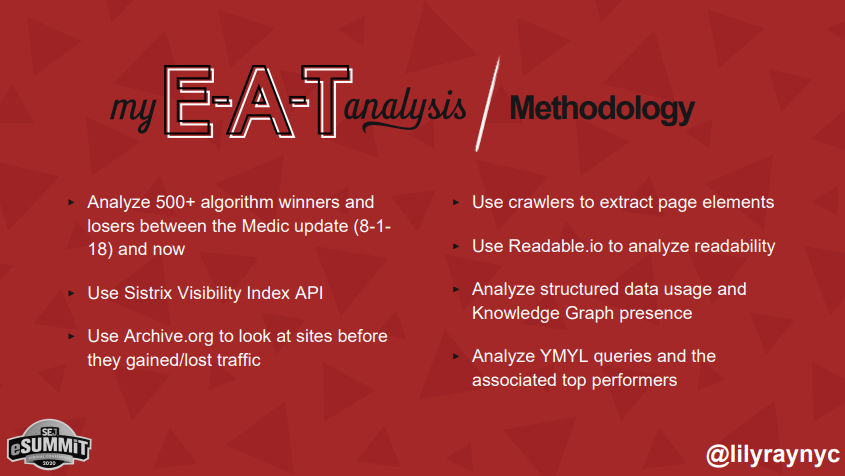
What Are Winning Sites Doing?
Disclose Who Their Authors Are & Utilize Expert Reviewers Whenever Possible
Healthline is an example of a site that does this tremendously.
Added the author names to all your articles but not seeing any impact?
It’s important to remember that the author bios – and expert reviewers – are not ranking factors in and of themselves.
Ideally, when using this process of having experts review content, they should ensure that your content is high-quality and evidence-based as part of that process.
Substantiate Claims
Substantiating your claims is important, especially for YMYL websites.
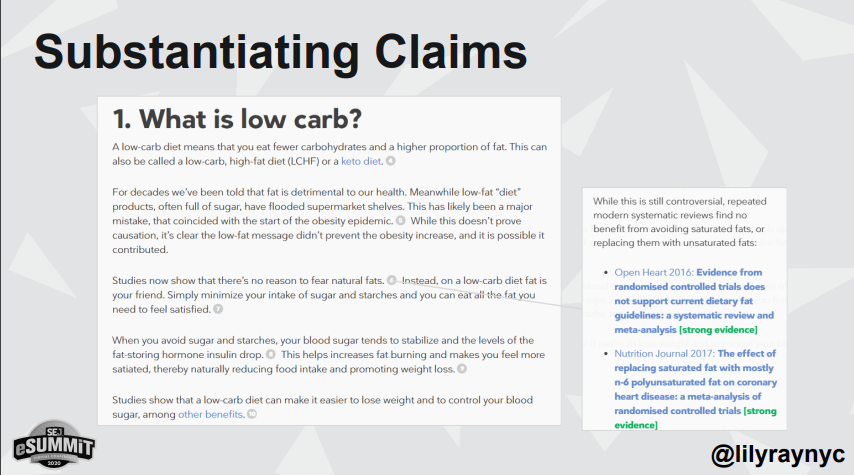
Think Google has no way of knowing who all of your authors are?
That’s true to an extent. Google can’t keep tabs on every single publisher on the web.
But it doesn’t mean they’re not trying.
Pay attention to what’s happening with the Knowledge Graph.
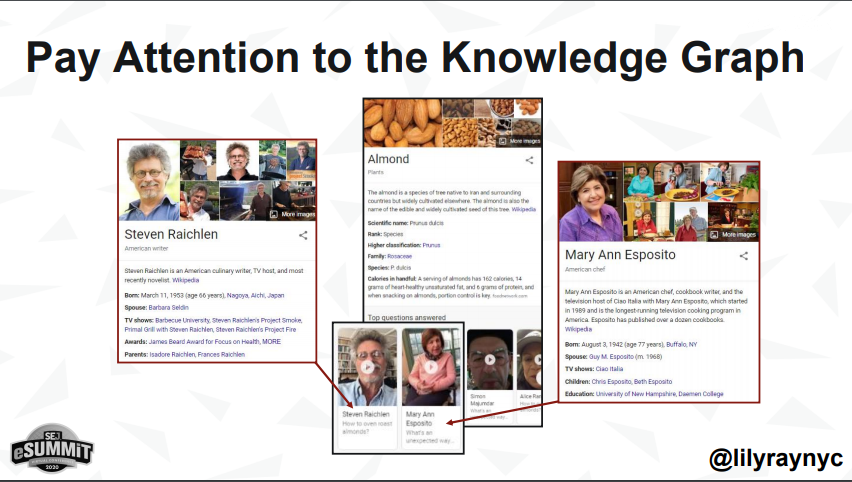
If you look up a certain variety of queries, such as “almond”, you’re going to see that there are experts listed at the bottom of the Knowledge Panel who actually provide short videos.
This is a program called Google Cameos in which Google asks these experts if they would be willing to answer a couple of questions about a certain topic.
If you look up the names of each expert, you’re going to see that they have their own personal Knowledge Graph which shows they are real experts that can be trusted to provide information about these topics.
Structured data can play a role in confirming your E-A-T.
You can even use Schema.org as a guide to inform what content you inc
To improve the expertise and authoritativeness of your content, you can use Person, Organization, or Local Business schema.
Use Your Crawler of Choice to Audit Your External Links
Ask yourself:
- Are they authoritative?
- Do you trust them?
- Do you want to be associated with them?
This is a great practice to go through when you’re auditing your E-A-T.
Eliminate Garbage Comments
Google has confirmed that comments on the page do factor into the overall quality of the page.
If you publish low-quality / spammy comments as a part of your website, that's what people (and search engines) will use when checking out your site. What you present is what you'll be perceived as, regardless of where the parts come from — just like any business.
— 🍌 John 🍌 (@JohnMu) February 27, 2020
If you’re a YMYL website, you don’t want low quality comments potentially weighing down the quality of the page and you may want to consider removing those comments entirely.
Conversely, if they’re good comments, maybe you want to keep them there and respond to those users.
Conduct Reputation Research
Eliminate your domain as one of the search results and look at things like reviews, scam, and fraud.
With this, you will see what’s the footprint of your brand’s reputation online and whether there are any issues that you need to address.
What Do Losing Sites Get Wrong?
On the flip side, websites with poor E-A-T resort to deception and shortcuts.
If you want to improve your E-A-T, you need to stop:
- Auto-generated content.
- Overwhelming advertisements or CTAs.
- Guilt-tripping calls to action.
- Overtly-salesy YMYL content.
- Lack of customer support.
- Not addressing bad reviews or Q&A.
- Distracting ads that are hard to close.
- Meaningless SEO content.
- Low-quality local landing pages.
- Mysteries about your brand or authors.
- Paid link campaigns.
The Takeaway
It’s important to remember that E-A-T initiatives can’t all be directly tied to confirmed SEO ranking factors, and that’s okay.
Improving E-A-T requires serious consideration of what is best for your users, not just for search engines.
Watch this Presentation
You can now watch Ray’s full presentation from SEJ eSummit on June 2.
More Resources:
- Surprising Facts About E-A-T
- Google’s E-A-T: Busting 10 of the Biggest Misconceptions
- How to Use Structured Data to Support E-A-T
Image Credits
All screenshots taken by author, July 2020
FAQ
What is Google's E-A-T?
According to Google, E-A-T is defined as:
“Expertise, authoritativeness, and trustworthiness of the creator of the main content, the main content itself, as well as the website.”
Is E-A-T a ranking factor?
E-A-T is not a direct ranking factor.
Expertise, authoritativeness, and trustworthiness are also not individual ranking factors.
Where did E-A-T come from?
The concept of E-A-T originated in the 2014 version of the Google Search Quality Guidelines, a 160-page document that explicitly defines what Google considers to be high or low quality content.
The guidelines are used to educate search quality raters, people who tasked by Google to conduct evaluations on the search results they are testing.

